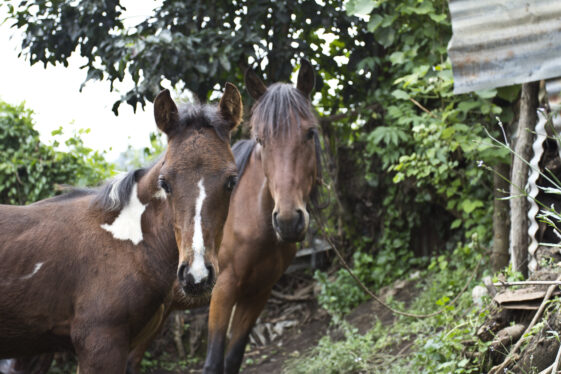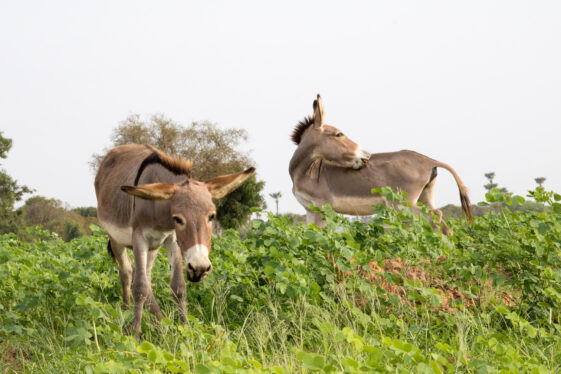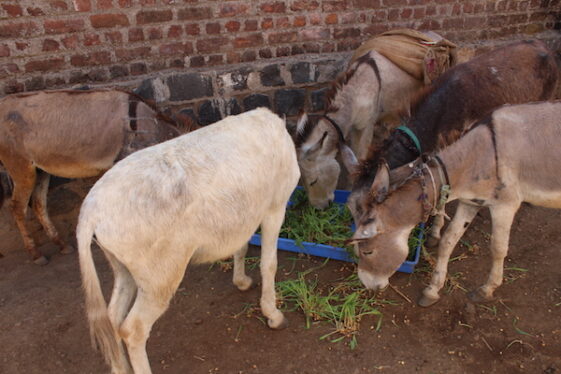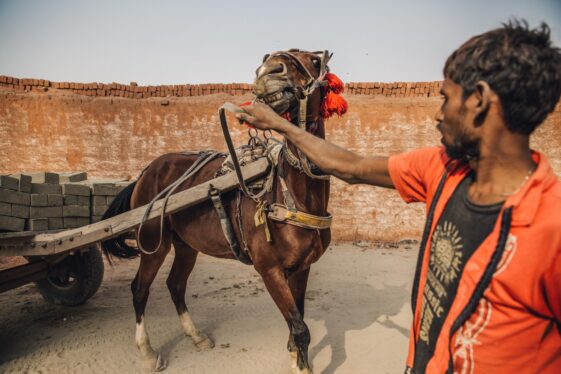QUICK LINKS
1.1 What is Animal Welfare?
1.2 How is Animal Welfare Assessed?
The Five Freedoms | The Five Domains
1.3 Animals Feelings and Needs?
1.1 What is Animal Welfare?
The World Organisation for Animal Health (OIE) defines animal welfare as animals having the opportunity to be healthy, comfortable, well nourished, safe, able to express innate behaviour and the absence of suffering. Animal welfare is not just the absence of suffering or avoidance of negative experiences but is also the promotion of positive experiences. It is both the physical and emotional state of an animal.
Understanding animal welfare from an animal’s perspective is key as THEY are the ones who decide if an experience is positive or negative to them. It is therefore important to understand that what animals need to experience good welfare will often vary from animal to animal, as well as depend on the context in which the animal lives (e.g. its environment, human attitudes and practices, and available resources). In addition, understanding and improving animal welfare can confer important benefits to both animals and people.
Animal welfare is assessed by measuring and evaluating how well an animal’s needs are being met in accordance with the animal’s natural behaviour. This will incorporate assessment of the environment in which the animal lives, whether the animal’s social needs are being met (e.g. being around, or away from other animals of the same kind), how well-nourished the animal is with appropriate nutrition, and the animal’s level of health, both physical and psychological. An animal’s welfare can also vary by factors such as seasonality, work type, animal age, gender, and/or owners’ practices, which is why making welfare assessment a regular, ongoing practice can be beneficial.
1.2 How is Animal Welfare Assessed?
There are many different models, or frameworks, for assessing or defining animal welfare, the most notable of which include the Five Freedoms and the Five Domains which are discussed in sections which follow.
Despite the existence of different assessment frameworks, it is helpful to consider concept of the “Balance of Life Experiences” when seeking to understand and promote animal welfare. In this concept, the ‘ideal’ of a ‘good life’ is something that all owners should strive to achieve by finding small incremental ways to improve an animal’s life experiences and bring their welfare to an acceptable, realistic standard that contributes to them having a life worth living. Brooke’s animal welfare policy provides an example of the practical application of the concept of promoting ‘a good life’ for animals.

Figure 1: Balance of Life Experiences (adapted from [2])
The Five Freedoms
The earliest, and most known, animal welfare guidance is the Five Freedoms. The five freedoms are widely known and used internationally across different species to outline what animals need and want [3]. The five freedoms have given focus to the importance of “understanding, identifying and minimising negative welfare states” [4].
The five freedoms include:
1. Freedom from thirst, hunger & malnutrition

Figure 2: The provision of readily accessible fresh water and nutritious feed are examples which support animals in experiencing freedom from hunger and thirst.
2. Freedom from discomfort & exposure

Figure 3: Example of an appropriate environment where shelter and a comfortable resting is provided to support animals in experiencing freedom from discomfort and exposure.
3. Freedom from pain, injury & disease

Figure 4: Prevention and early diagnosis and treatment are examples which can support animals in experiencing freedom from pain, injury, or disease.
4. Freedom from fear & distress

Figure 5: Ensuring conditions and treatment which avoid mental suffering support animals in experiencing freedom from fear and distress.
5. Freedom to express normal behaviour

Figure 6: Providing animals with sufficient space, proper facilities and company of the animal's own kind supports their ability to freely express normal behaviour.
However, as the five freedoms focus is on relieving or avoiding suffering, there is limited focus on the promotion of positive states. Evidence to prove an animal’s ability to experience emotions, such as pain, fear, and stress along with joy, affection, and happiness, has led to welfare assessment being developed to allow for this and to encourage the promotion of positive experiences rather than just alleviating negative.
The Five Domains
The five domains framework for welfare assessment evolved from earlier frameworks to focus on the promotion of positive states of welfare, while continuing to minimise negative ones [2]. The first three domains of nutrition, environment and health focus on the physical condition or state, while the fourth domain of behaviour focuses on the surroundings that can promote or limit the expression of natural behaviour (e.g. the environment, humans, or other animals). These four domains feed into the fifth, the ‘Mental States’ domain, which is the emotions and moods an animal feels, which in turn determines their welfare status. Mental state can be positive or negative, passive, or active.

1. Nutrition
The process of providing or obtaining the food necessary for health & growth.
If feeding higher quality or increased quantity of feeds is not possible, other ways of making improvements in this domain could be feeding animals away from one another to avoid resource guarding or bullying or ensuring that small amounts of forage are always available rather than a large amount fed infrequently.
Figure 7: Providing fresh fodder to working donkeys in small amounts throughout the day to ensure they remain healthy and have sufficient energy as they work.
2. Environment
The surroundings or conditions in which an animal lives or operates can either create conditions of comfort or discomfort.
Promoting comfortable living and working environments for animals can support their welfare, for example by clearing rubbish or hazardous items from the environment, ensuring that social species have the option to be around others of their species, and that all animals are given an opportunity to have free unrestricted movement for at least part of the day and are not tied up.
Figure 8: Example of donkeys in and environment littered with rubbish which can be hazardous to their health when consumed.


3. Health
A state of complete physical, mental, and social well-being and not merely the absence of disease or infirmity (as defined by the World Health Organisation).
Ensuring that steps are taken to PREVENT health conditions like disease, wounds and lesions, lameness, foot related health issues, eye infections, etc. This can be done by ensuring recommended vaccine schedules are followed, that equipment (e.g. tack, harnesses, collar) is correctly fitted and not rubbing in a particular area, by wiping eyes clean from dust and debris, treating wounds with appropriate products, balancing loads, and not working animals when they are too young, and seeking veterinary advice and help as soon as possible when needed.
Figure 9: Regular cleaning and trimming of hooves is a preventative measure to mitigate lameness in horses.
4. Behaviour
The way in which an animal behaves in response to a particular situation or stimulus, whereby the animal can express its natural behaviours, including satisfying and engaging environment-focused and inter-animal activities.
This also includes handling, which describes how a human works with, responds to or interacts with an animal in its surroundings.
Figure 10: Example of positive human-animal interaction because of compassionate handling.

For most animals, handling is essential for their management and healthcare. However, for working animals, handling is prevalent each day of their lives. These animals work and live alongside people, meaning that handling is one of the most frequent events they experience. If handling is inhumane then it is relentless and enduring. However, if handling is compassionate, it can be an enjoyable experience for them. Handling can be a way to increase the number of positive experiences that an animal has across its lifetime. [5]
Animals remember whether an interaction with a human has been positive or negative and this will affect the way they behave, with negative human-animal interactions more likely to result in fear behaviour. Handling should correspond with LIMA principles (Least Invasive Minimally Aversive) [6]. By treating your animal compassionately, ensuring that handling is done in a calm, patient, kind way, this will result in a happier animal where the behavioural domain is met. It is equally important to allow an animal with opportunities to exhibit normal behaviour, such as social interactions with its own species, foraging and grazing behaviour and locomotion.

5. Mental State
Positive and negative experiences within the other four domains influence whether an animal’s mental state is positive or negative.
For example, if an animal is hungry or thirsty, they will experience negative emotions, while if an animal is being handled calmly and shown compassion, they will likely experience positive emotions.
While animals may display quick, emotional responses to an immediate stimulus, they also experience affective states which are longer lasting mood states (such as anxiety or depression) because of an accumulation of experiences. Thus, to improve animal welfare it is important to seek to understand and assess both their positive AND negative experiences within each domain and consider how an animal’s experiences within each of the four domains may be contributing to its mental state AND influencing its overall welfare.
Figure 11: Example of an animal experiencing a negative mental state.
The "Five Domains" model for assessing animal welfare
![Figure 12: The "Five Domains" model for assessing animal welfare [2]](https://communitiesforanimals.thebrooke.org/wp-content/uploads/2022/04/A1-Welfare-English-version.png)
Figure 12: The "Five Domains" model for assessing animal welfare [2]
Examples of positive & negative experiences within the Five Domains framework
![Figure 13: Examples of positive and negative experiences within the Five Domains framework [7]](https://communitiesforanimals.thebrooke.org/wp-content/uploads/2022/04/A3-Domains-Positive-and-Negative-English-ver.png)
Figure 13: Examples of positive and negative experiences within the Five Domains framework [7]
Comparing the Five Freedoms and Five Domains of Animal Welfare Frameworks
The five freedoms aims to ensure that the animal is completely free of all the specific negative areas, and this can be seen as unrealistic or difficult to achieve, especially with working animals or in Low- or Middle-Income Countries (LMICs). Whereas the five domains considers the fulfilment of more domains as more important for the animal than improvement in a few separate indicators. The other key difference between the two frameworks for assessing welfare, is that the five freedoms focuses on avoidance of negative suffering, and views welfare as a potentially negative concept, whereas the five domains focuses on promoting positive welfare and views welfare as encapsulating the experiences, positive and negative, that animals have over their lifetime.
With the five domains, the crucial element is that each domain is addressed in some way. Gradual improvements in all five domains are more important than a big, or many, improvements in one domain, whilst other domains go unmet. For owners struggling to determine how they can meet each domain, some real-life examples are given below. Creating opportunities to meet elements within each of the five domains should be prioritized by communities with animals.
“The overall objective is to provide opportunities for animals to ‘thrive’ not simply ‘survive’…” [4]
1.3 Animals Feelings and Needs
Not only do animals have senses such as sight, hearing, etc. but they can also experience emotions associated with those senses, such as taking pleasure in eating tasty food, comfort, and security by socializing with others of their species etc., which is why animals are recognized as sentient beings. Animal sentience is defined as recognizing animals as sentient beings that can be aware of their own feelings and emotions. This includes both having the ability to have both negative feelings like pain, frustration, and fear as well as positive feelings like comfort, enjoyment, and contentment.
One of the best ways to understand what animals need is to observe them.
PRACTICE ACTIVITY
Observe Which Animal Welfare Needs are Being Met/Unmet
Watch the example videos provided below, or alternatively observe animals in their local context with community members for five to ten minutes.
Consider the five domains framework for assessing animal welfare, and make a list of:
1) the things the animals need which they are getting from their environment, resources and/or people around them, and
2) the things the animals need which they are not getting from their environment, resources and/or people around them.
Working Donkeys in Coal-mine, Pakistan
Working Donkey in Brick Kiln, Pakistan
People and animals are similar in their needs and in their basic feelings or emotions. They are likely to feel quite like you about things which affect their needs and their daily life. Think about what you need to have to have a good life and be happy in terms of your environment, health, nutrition, and behaviour? What do you need to experience and be provided with?
To help you see the world from an animal's perspective, imagine a 'being of unknown origin' appears in your community one day that you don't know anything about.
What does this 'being' need, to have good life?

Use the questions below to help you determine what this 'being' may need
to meet its welfare needs and if it has a good life and is happy.
NUTRITION
What does this 'being' need to ensure their nutritional needs are met?
- Water and nutritious food - what kind of food/water and how much do they need?
- How often do they need to eat (once a day, constantly throughout the day)?
- How do they like to eat/be fed (e.g. on the ground, up high, alone, in the company of friends)?
ENVIRONMENT
What does this 'being' need from their enviroment?
- What things might they need to help them feel safe and comfortable?
- What do they need to rest safely and comfortably overnight (should this be dark, light, cold, hot, what kind of substrate)?
- Do they require heat/sun, cooler temperatures, or wet/moist environments?
- Can they handle exposure from excessive sun/heat/moisture?
MENTAL
What signs might you look for
to know if they are happy?
HEALTH
What does this 'being' need to ensure their health needs are met? from their environment?
- To keep then well and not get sick?
- To ensure they can move comfortable and not be in pain?
- What provisions might they need to address or prevent injury in this new landscape (e.g. preventative care measures, foot care,)?
- What are their options for receiving prompt treatment should ailments arise?
BEHAVIOUR
What does this 'being' need to ensure their behavioural needs are met?
- Are they being handled compassionately and have positive interactions with humans (e.g., are they naturally confident or wary towards humans)?
- Do they have sufficient free time to rest? (e.g. breaks or down time from activities or interactions)
- Can they express their natural behaviours (e.g. foraging, playing, socializing with others)
- Do they have opportunities to make choices (e.g. in how they spend their time, who they spend their time with, where they go)?
Figure 14: Animal Welfare Needs Analysis Reflection Activity
Promoting understanding of animals’ needs, feelings, and lived experiences from the perspective of animals can be helpful to promoting empathy and compassion for animals, and related positive animal-human interactions. Similarly, understanding the importance of animals to people, and the nature of the human-animal relationship will help you understand how you may be able to communicate and motivate people to improve their animals’ welfare by framing the benefits of change in terms of what they most value about their animals.